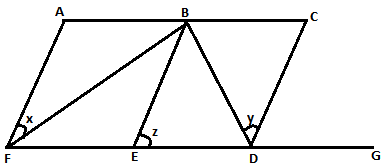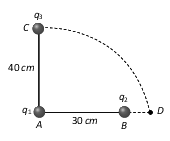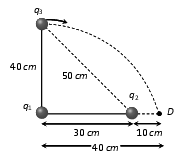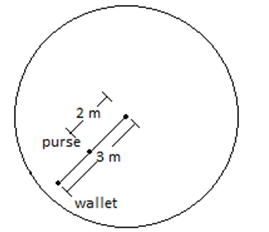12th Grade > Physics
WORK POWER AND ENERGY MCQs
Work And Energy, Sources Of Energy, Electric Potential Energy Potential And Dipoles
Total Questions : 109
| Page 4 of 11 pages
Answer: Option A. -> 0.006 J
:
A
W=U2−U1=14πϵ0q1q2[1r2−1r1]=9×109×10−12[11−13]=9×23×10−3W=0.006J
:
A
W=U2−U1=14πϵ0q1q2[1r2−1r1]=9×109×10−12[11−13]=9×23×10−3W=0.006J
Answer: Option C. -> 4kQ2Q3
:
C
ΔU=Uf−UiUf=k[Q1Q20.6+Q2Q30.2+Q3Q10.8]ΔU=Uf−Ui=kQ2Q3[10.2−1]=4kQ2Q3
:
C
ΔU=Uf−UiUf=k[Q1Q20.6+Q2Q30.2+Q3Q10.8]ΔU=Uf−Ui=kQ2Q3[10.2−1]=4kQ2Q3
Answer: Option B. -> 3.2×10−18J
:
B
K.E.=q0(VA−VB)=1.6×10−19(70−50)=3.2×10−18J
:
B
K.E.=q0(VA−VB)=1.6×10−19(70−50)=3.2×10−18J
Answer: Option C. -> 27 J
:
C
For pair of charge U=14πϵ0[10×10−6×10×10−610100+10×10−6×10×10−610100+10×10−6×10×10−610100]
=3×9×109×100×10−12×10010=27J
:
C
For pair of charge U=14πϵ0[10×10−6×10×10−610100+10×10−6×10×10−610100+10×10−6×10×10−610100]
=3×9×109×100×10−12×10010=27J
Answer: Option C. -> 5q6R
:
C
Charge of -q will be induced on the the inner surface and +q on the outer surface
V=V1+V2+V3=14πϵ0[qR−q2R+q3R]
V=14πϵ0[6q−3q+2q6R]
V=14πϵ0[5q6R]
:
C
Charge of -q will be induced on the the inner surface and +q on the outer surface
V=V1+V2+V3=14πϵ0[qR−q2R+q3R]
V=14πϵ0[6q−3q+2q6R]
V=14πϵ0[5q6R]
Answer: Option D. -> 1.6×10−14 joule
:
D
Energy = qV= 1.6×10−19×100000=1.6×10−14J
:
D
Energy = qV= 1.6×10−19×100000=1.6×10−14J
Answer: Option B. -> −q√3
:
B
PE=0
314πϵ0q2a+314πϵ0×qx(a√3)=0√3x=−qx=−q√3
:
B
PE=0
314πϵ0q2a+314πϵ0×qx(a√3)=0√3x=−qx=−q√3
Answer: Option D. -> May be at +ve, zero or -ve potential
:
D
May be at positive, zero or negative potential, it is according to the way one defines the zero potential.
:
D
May be at positive, zero or negative potential, it is according to the way one defines the zero potential.




















